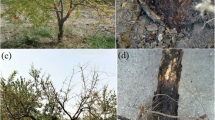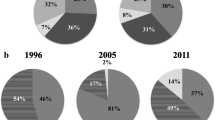Abstract
Erwinia persicina (Ep) is a phytopathogenic bacteria found on Medicago sativa, Glycine max, Phaseolus vulgaris and Pisum sativum. It has also been isolated from healthy tomato, cucumber, banana, apple and pear, as well as the human urinary tract and biofilms located on paleolithic rock paintings. The host range and environmental adaptation capacity of Ep, and its life cycle on the lucerne plant, was studied. It was found that an Ep infection, which could be transmitted by seeds, water, and soil, caused necrosis and wilting of the whole mature lucerne plant. Subsequently, 15 genera and 22 species of forage or grain legumes were chosen to determine the pathogenicity of Ep. Among them were 11 genera and 19 species (e.g., Vigna angularis, Arachis hypogaea, Onobrychis viciaefolia, Astragalus adsurgens, etc.) reported as new hosts. The environmental adaptation capacity of Ep indicated its probable survival within a wide range of environmental conditions and an ability to endure arid, saline and alkaline environments. Based on the results of the life cycle, host range and environmental adaptation capacity of Ep, it was concluded that Ep could pose a new threat to forage or grain legumes production within farming systems.




Similar content being viewed by others
References
Barak, J. D., & Schroeder, B. K. (2012). Interrelationships of food safety and plant pathology: the life cycle of human pathogens on plants. Annual Review of Phytopathology, 50, 12.1–12.26.
Brenner, D. J., Neto, J. R., Steigerwalt, A. G., & Robbs, C. F. (1994). “Erwinia nulandii” is a subjective synonym of Erwinia persicinus. International Journal of Systematic Bacteriology, 44, 282–284.
Brenner, D. J., Krieg, N. R., & Staley, J. T. (2005). Bergey’s manual of systematic bacteriology, Vol. 2, Part B (2nd ed.). New York: Springer Verlag.
CDC (2012). Multistate foodborne outbreaks. Atlanta, GA: CDC. http://www.cdc.gov/outbreaknet/outbreaks.html.
Ceri, H., Olson, M. E., Stremick, C., Read, R. R., Morck, D., & Buret, A. (1999). The Calgary Biofilm Device: new technology for rapid determination of antibiotic susceptibilities of bacterial biofilms. Journal of Clinical Microbiology, 37, 1771–1776.
Cui, R. Q., Hu, X. N., Liao, J. L., Zhong, G. Q., Guo, Q., Wang, W. F., et al. (2009). Isolation and identification of bacterial pathogen causing wilton pea seed imported from Australia. Acta Psychopathologica Sinica, 39, 238–242 (In Chinese with English abstract).
Davies, D. (2003). Understanding biofilm resistance to antibacterial agents. Nature Reviews Drug Discovery, 2, 114–122.
Davis, M. J., Gillaspie, A. G., Jr., Vidaver, A. K., & Harris, R. W. (1984). Clavibacter: a new genus containing some phytopathogenic coryneform bacteria, including Clavibacter xyli subsp. xyli sp. nov., subsp. nov. and Clavibacter xyli subsp. cynodontis subsp. nov., pathogens that cause ratoon stunting disease of sugarcane and Bermuda-grass stunting disease. International Journal of Systematic Bacteriology, 34, 107–117.
De León, L., Siverio, F., López, M. M., & Rodríguez, A. (2011). Clavibacter michiganensis subsp. michiganensis a seedborne tomato pathogen: healthy seeds are still the gaol. Plant Disease, 95, 1328–1339.
Diánez, F., Santos, M., Font, I., de Cara, M., & Tello, J. C. (2007). New hosts for the enterobacterial phytopathogen Erwinia persicina. In A. Mendez-Vilas (Ed.), Current research topics in applied microbiology and microbial biotechnology. Singapore: World Scientific Press, Ltd.
Euzéby, J. P. (1998). Taxonomic note: necessary correction of specific and subspecific epithets according to Rules 12c and 13b of the International Code of Nomenclature of Bacteria (1990 revision). International Journal of Systematic Bacteriology, 48, 1073–1075.
Frame, J. (2001). Advances in forage legume technology. Acta Prataculturae Sinica, 10, 1–17.
Gehring, I., & Geider, K. (2012). Identification of Erwinia species isolated from apples and pears by differential PCR. Journal of Microbiological Methods, 89, 57–62.
González, A. J., Tello, J. C., & de Cara, M. (2005). First report of Erwinia persicina from Phaseolus vulgaris in Spain. Plant Disease, 89, 109.
González, A. J., Tello, J. C., & Rodicio, M. R. (2007). Erwinia persicina causing chlorosis and necrotic spots in leaves and tendrils of Pisum sativum in southeastern Spain. Plant Disease, 91, 460.
Hall-Stoodley, L., Costerton, J. W., & Stoodley, P. (2004). Bacterial biofilms: from the natural environment to infectious diseases. Nature Reviews Microbiology, 2, 95–108.
Hao, M. V., Brenner, D. J., Steigerwalt, A. G., Kosako, Y., & Komagata, K. (1990). Erwinia persicinus, a new species isolated from plants. International Journal of Systematic Bacteriology, 40, 379–383.
Hymowitz, Z. (1990). Grain legumes. In J. Janick & J. E. Simon (Eds.), Advances in new crops (pp. 54–57). Porland: Timber Press. http://www.hort.purdue.edu/newcrop/proceedings1990/V1-154.html.
Itoh, Y., Sugita-Koni, S. Y., Kasuga, F., Iwaki, M., Hara-Kudo, Y., Saito, N., et al. (1998). Enterohemorrhagic Escherichia coli O157:H7 present in radish sprouts. Applied and Environment Microbiology, 64, 1532–1535.
Kiessling, P., Senchenkova, S. N., Ramm, M., & Knirel, Y. A. (2005). Structural studies on the exopolysaccharide from Erwinia persicina. Carbohydrate Research, 340, 1761–1765.
Kim, J., Hahn, J. S., Franklin, M. J., Stewart, P. S., & Yoon, J. (2009). Tolerance of dormant and active cells in Pseudomonas aeruginosa PA01 biofilm to antimicrobial agents. Journal of Antimicrobial Chemotherapy, 63, 129–135.
Michel, B. E., & Kaufmann, M. R. (1973). The osmotic potential of polyethylene glycol 6000. Plant Physiology, 51, 914–916.
Nan, Z. B. (1995). Fungicide seed treatments of sainfoin control seed-borne and root-invading fungi. New Zealand Journal of Agricultural Reseach, 38, 413–420.
Neergaard, P. (1977). Seed pathology. London: The MacMillan Press, Ltd.
Nemeth, J., Laszlo, E., & Emody, L. (1991). Clavibacter michiganensis ssp. Insidiosus in lucerne seeds. EPPO Bulletin, 21, 713–718.
O’Hara, C. M., Steigerwalt, A. G., Hill, B. C., Miller, J. M., & Brenner, D. J. (1998). First report of a human isolate of Erwinia persicinus. Journal of Clinical Microbiology, 36, 248–250.
OEPP/EPPO. (2010). Clavibacter michiganensis subsp. Insidiosus. OEPP/EPPO Bulletin, 40, 353–364.
Sharma, K. D., Chen, W., & Muehlbauer, F. J. (2005). Genetics of chick pea resistance to five races of fusarium wilt and a concise set of race differentials for Fusarium oxysporumf sp. ciceri. Plant Disease, 89, 385–390.
Suslow, T. V., Schroth, M. N., & Isaka, M. (1982). Application of a rapid method for Gram-differentiation of plant pathogenic and saprophytic bacteria without staining. Phytopathology, 72, 917–918.
Thirthamallappa, & Lohithaswa, H. C. (2000). Genetics of resistance to early blight (Alternaria solani Sorauer) in tomato (Lycopersicon esculentum L.). Euphytica, 113, 187–193.
Warriner, K., Spaniolas, S., Dickinson, M., Wright, C., & Waites, W. M. (2003). Internalization of bioluminescent Escherichia coli and Salmonella Montevideo in growing bean sprouts. Journal of Applied Microbiology, 95, 719–727.
Watanabe, Y., Ozasa, K., Mermin, J. H., Griffin, P. M., Masuda, K., Imashuku, S., et al. (1999). Fatory outbreak of Escherichia coli O157:H7 infection in Japan. Emerging Infectious Diseases, 81, 867–872.
Wilson, E. E., Zeitoun, F. M., & Fredrickson, D. L. (1967). Bacterial phloem canker, a new disease of Persian Walnut trees. Phytopathology, 57, 518–621.
Zhang, Z. F., & Nan, Z. B. (2012). First report of Erwinia persicinus causing wilting of Medicago sativa sprouts in China. Plant Disease, 96, 454.
Zhang, Z. F., & Nan, Z. B. (2013). Occurrence of lucerne seed-borne Enterobacter cloacae sprouts decay in Gansu Province of China. European Journal of Plant Pathology, 135, 5–9.
Acknowledgements
We would like to thank Prof. Yanrong Wang for supplying the forage legume seeds, Prof. Xiurong Chen and Dr. Xingxu Zhang for technical assistance. We are grateful to Ross Booth and two anonymous reviewers for reviewing the manuscript. This research was financially supported by the National Key Basic Research Program (973) of China (2014CB138704) and National Construction of Modern Agricultural Industrial Technology Systems of China – Forage Industrial Technology Systems.
Author information
Authors and Affiliations
Corresponding author
Rights and permissions
About this article
Cite this article
Zhang, Z., Nan, Z. Erwinia persicina, a possible new necrosis and wilt threat to forage or grain legumes production. Eur J Plant Pathol 139, 349–358 (2014). https://doi.org/10.1007/s10658-014-0390-0
Accepted:
Published:
Issue Date:
DOI: https://doi.org/10.1007/s10658-014-0390-0




